What If Canada Became the 51st U.S. State? A Data-Driven Analysis of Economic, Political, and Cultural Impacts
Exploring the Economic, Political, and Cultural Shifts That Would Redefine North America and the World
Canada, the world’s second-largest country by landmass, could dramatically reshape the United States if it were to become the 51st state. This hypothetical scenario would not only impact North America’s geopolitical power but would also bolster the U.S. economy and elevate its influence in global rankings.
The integration of Canada’s vast natural resources, military strength, and thriving industries could supercharge America’s global dominance. As the U.S. is already a world leader in both military and economic influence, incorporating Canada could propel it to new heights of global power.
In this data-driven analysis, we’ll examine how Canada’s integration as the 51st U.S. state would affect GDP growth, Arctic resource control, healthcare systems, and the global political landscape. We’ll also explore how this merger could redefine the future for both nations and reshape the world’s balance of power.
Can the U.S. and Canada together create an unstoppable global superpower? Let’s explore the numbers and find out.
1. Economic Transformation
Current U.S. Economic Standings
The United States boasts a GDP of approximately $26.5 trillion, making up 26.3% of the global economy. It leads the world in key industries, including:
Finance, Insurance, Real Estate, Rental, and Leasing: Contributing 20.7% to the economy. (Statista)
Professional and Business Services: Adding another 13%.
Manufacturing: Representing 11% of GDP.
This robust economic foundation has helped the U.S. maintain its position as the global economic leader.
Canada's Economic Contributions
With a GDP of $2.14 trillion, Canada ranks as the world's 10th largest economy. Known for its abundant natural resources, Canada contributes significantly to global markets through:
Oil Reserves: Holding 13% of global reserves, ranking third worldwide. (Wikipedia)
Freshwater Resources: Controlling 20% of the world’s freshwater—a critical asset in a resource-scarce future.
Mineral Wealth: Leading in exports of zinc, uranium, gold, nickel, and aluminum.
Key Industries:
Natural resources account for 19.2% of Canada’s nominal GDP. (Government of Canada)
Manufacturing sectors, particularly automobiles and aeronautics, are prominent.
Technology and agriculture are also growing economic pillars.
Impact of Integration
If Canada joined the U.S. as the 51st state, the economic transformation would be profound:
Combined GDP: A staggering $27.59 trillion, further solidifying the U.S.'s position as the largest economy globally.
Resource Wealth:
Increased control over 13% of the world’s oil reserves.
Dominance in global freshwater supplies, offering strategic advantages.
Enhanced access to vital minerals for technology and manufacturing.
Trade Simplification:
Elimination of trade barriers and tariffs.
Integrated supply chains across industries.
New markets for U.S. and Canadian businesses.
2. Political Realignment
When imagining Canada joining the United States as the 51st state, the political implications are enormous. This section delves into how such an integration would transform the political landscape, both domestically within the U.S. and globally.
Congressional Representation
The United States Congress would need to accommodate Canada's population of 40 million, spread across 10 provinces and 3 territories. Based on population size, Canada could add an estimated 50 seats to the House of Representatives and 26 Senators (2 for each province/territory). This would significantly shift the political dynamics in Congress.
Such an adjustment could impact:
Party Balance: Canada's generally progressive population might lean Democratic, potentially reshaping the balance of power.
State Dominance: Provinces like Ontario and Quebec, with the largest populations, would gain substantial influence in Congress.
Electoral College Impact
Canada’s population of 40 million would add roughly 70 electoral votes, bringing the total from 538 to 608 votes. This increase could redefine how presidential campaigns are conducted:
Ontario and Quebec, as the most populous regions, would likely become critical battlegrounds.
Canadian voters might shift the overall balance in presidential elections.
This expanded electoral map would make campaigns more complex, with candidates needing to address the unique concerns of Canadian voters, such as universal healthcare and environmental policies.
Global Influence
A united U.S. and Canada would create an unmatched geopolitical powerhouse, strengthening influence in organizations like NATO, the G7, and the United Nations. Key advantages include:
Arctic Dominance: With Canada’s Arctic territories, the U.S. would gain unrivaled control over strategic shipping lanes and natural resources.
Trade Leverage: Canada’s position as a major trading partner would enhance North America’s negotiating power in global markets.
Military Strength: Canada’s military, while smaller, would bolster U.S. forces, especially in Arctic defense.
This integration would make North America the undisputed leader in both economic and military terms, reinforcing its global dominance.
3. Social and Cultural Impacts
Population Dynamics
Canada’s population of 40 million would bring the combined U.S. population to ~374 million, making it the third most populous country after India and China. The integration would introduce new demographic trends:
Population Density: Canada’s vast land area but low population density (~4 people per km²) contrasts sharply with the U.S.
Diversity: Canada’s multicultural population would enrich the U.S.’s diversity further, especially in French-speaking regions like Quebec.
Healthcare Systems
One of the starkest contrasts is healthcare:
Canada: Universal healthcare system funded by taxes.
U.S.: Predominantly privatized healthcare system, with significant debates over costs and access.
Integration Challenge: Balancing the two systems would be politically and logistically complex, requiring extensive reforms.
Cultural Identity
Canada’s distinct cultural identity would need to merge with that of the U.S., presenting unique challenges and opportunities. Below, we explain how the key cultural differences between the two nations, as illustrated in the radar chart, reflect these complexities:
Language Diversity:
Canada scores high in bilingualism (80) due to its French-speaking population in Quebec and national policies promoting both English and French. In contrast, the U.S. has a lower score (20) as it predominantly operates in English. This integration would introduce bilingualism on a much larger scale, requiring significant adjustments in public communication and education systems.
Cultural Values:
The radar chart highlights Canada’s strong emphasis on healthcare access (80), environmental policies (80), and social equity (85), compared to the U.S. scores of 55, 50, and 60, respectively. These differences could influence U.S. policies, as Canada’s values might push for greater social welfare programs, stricter environmental regulations, and equity-focused reforms.
Resistance in Quebec:
The radar chart indirectly reflects Quebec’s unique cultural identity through Canada’s high bilingualism and equity scores. Quebec’s historical push for independence could create cultural and political friction during integration. The challenge lies in ensuring that Quebec feels represented within a U.S. system that prioritizes individual states' rights over centralized cultural policies.
Radar Chart Insight:
The radar chart visually demonstrates how the U.S. and Canada differ significantly across cultural dimensions. For example:
Gun Ownership: The U.S. leads with 90, reflecting the cultural significance of the Second Amendment, while Canada’s score of 20 highlights stricter gun laws.
Bilingualism: Canada’s high score (80) shows its inclusive language policies, compared to the U.S.’s limited bilingual support (20).
This chart illustrates the opportunities and challenges in merging these cultural values, highlighting areas where collaboration could lead to mutual growth or tension. Integrating such diverse values will require strategic and sensitive policymaking to balance these cultural contrasts.
4. Global Power Rankings
When Canada joins the United States as the 51st state, the resulting entity would not only redefine the North American landscape but also reshape global rankings across multiple domains. Here’s how this merger would strengthen their combined global influence:
Military Dominance
The United States already leads the world in military spending, allocating ~$800 billion annually, compared to Canada’s ~$26 billion. While Canada’s military contribution may seem modest, its geographical advantage and Arctic capabilities would significantly enhance U.S. strategic dominance.
Key impacts:
Arctic Supremacy: Canada’s extensive Arctic territories provide access to newly available trade routes and untapped resources as ice caps melt. This would establish the U.S.-Canada entity as the dominant player in Arctic geopolitics.
Enhanced Security: A unified force could secure critical shipping lanes and deter threats from rival powers like Russia and China, which also seek influence in the Arctic.
Economic Influence
With a combined GDP of $28.2 trillion, the U.S.-Canada entity would account for 28% of global GDP, reinforcing its position as the world’s economic powerhouse. This integration would:
Strengthen its negotiating power in international organizations such as the World Trade Organization (WTO) and the G7.
Dominate global trade through control of Arctic routes, reducing reliance on traditional shipping lanes like the Panama and Suez Canals.
Quality of Life
Canada currently ranks 2nd globally in quality of life, while the U.S. ranks 3rd. The integration could:
Improve healthcare access and environmental policies by adopting Canada’s progressive frameworks.
Enhance infrastructure and public services by leveraging shared resources.
This combination could elevate the North American region to the top global ranking in quality of life metrics.
Arctic Supremacy
As a united entity, the U.S. and Canada would become the leading Arctic power. With melting ice revealing new trade opportunities and natural resources, the combined nation would:
Control key Arctic shipping lanes, connecting North America, Europe, and Asia.
Gain unparalleled influence over natural gas, oil, and mineral reserves in the region.
Lessons from Germany’s Reunification
’s comment draws a fascinating parallel between a hypothetical USA-Canada union and Germany’s reunification in 1989. The €2 trillion cost of Germany’s reunification highlights the immense challenges of merging two distinct regions. Decades later, economic disparities and cultural divisions between East and West Germany remain unresolved, offering a cautionary tale for any large-scale integration.Canada’s resource-based economy and welfare-focused policies stand in sharp contrast to the USA’s innovation-driven, individualistic ethos. As Michael points out, these differences could create economic and social friction, much like the industrial and cultural gaps seen in post-reunification Germany. Additionally, Canada’s historical ties to the British Crown reinforce its unique identity, complicating any move toward integration with the USA.
Germany’s experience shows that unification isn’t just about economic alignment—it involves navigating deep cultural and political divides. These insights add a critical layer to this discussion, reminding us that merging two nations is far more complex than it seems on paper.
Conclusion
The integration of Canada into the United States would create a global superpower, unmatched in military strength, economic influence, and Arctic dominance. However, the strategic advantages must be balanced with careful policymaking to align goals and address challenges in governance, culture, and infrastructure.
Inspiration for This Analysis
The idea for this article was inspired by a recent post from Leading Report, where it was claimed that former U.S. President Donald Trump suggested Canada should become the 51st state of the United States. The hypothetical conversation highlighted economic challenges and strategic advantages, sparking curiosity about what such a merger would entail.
This analysis dives deeper into the implications of such a bold idea, offering data-driven insights into how the integration of Canada as the 51st state could reshape the political, economic, and cultural landscape of North America and the world.
What do you think? Do you have any ideas on what else could be explored in this article? Or perhaps you have your own take on what a U.S.-Canada union could mean for the world?
Feel free to leave a comment below or send me a message. I'd love to hear your thoughts and continue the conversation!


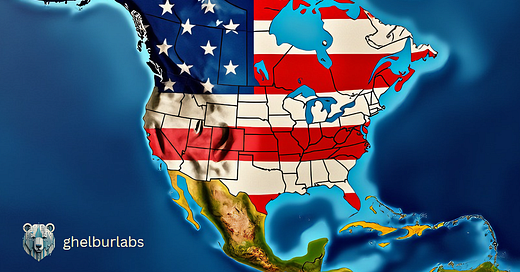






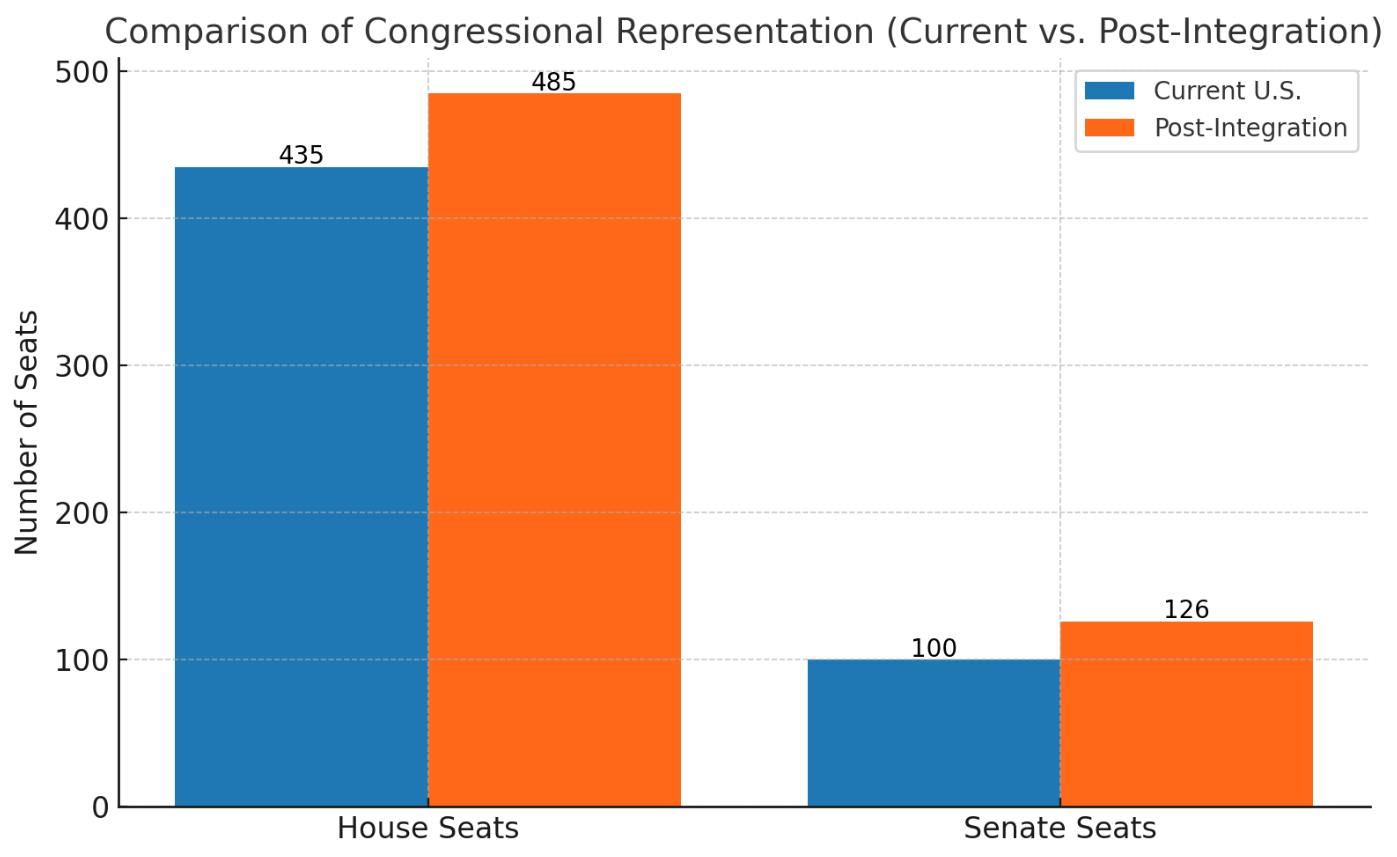

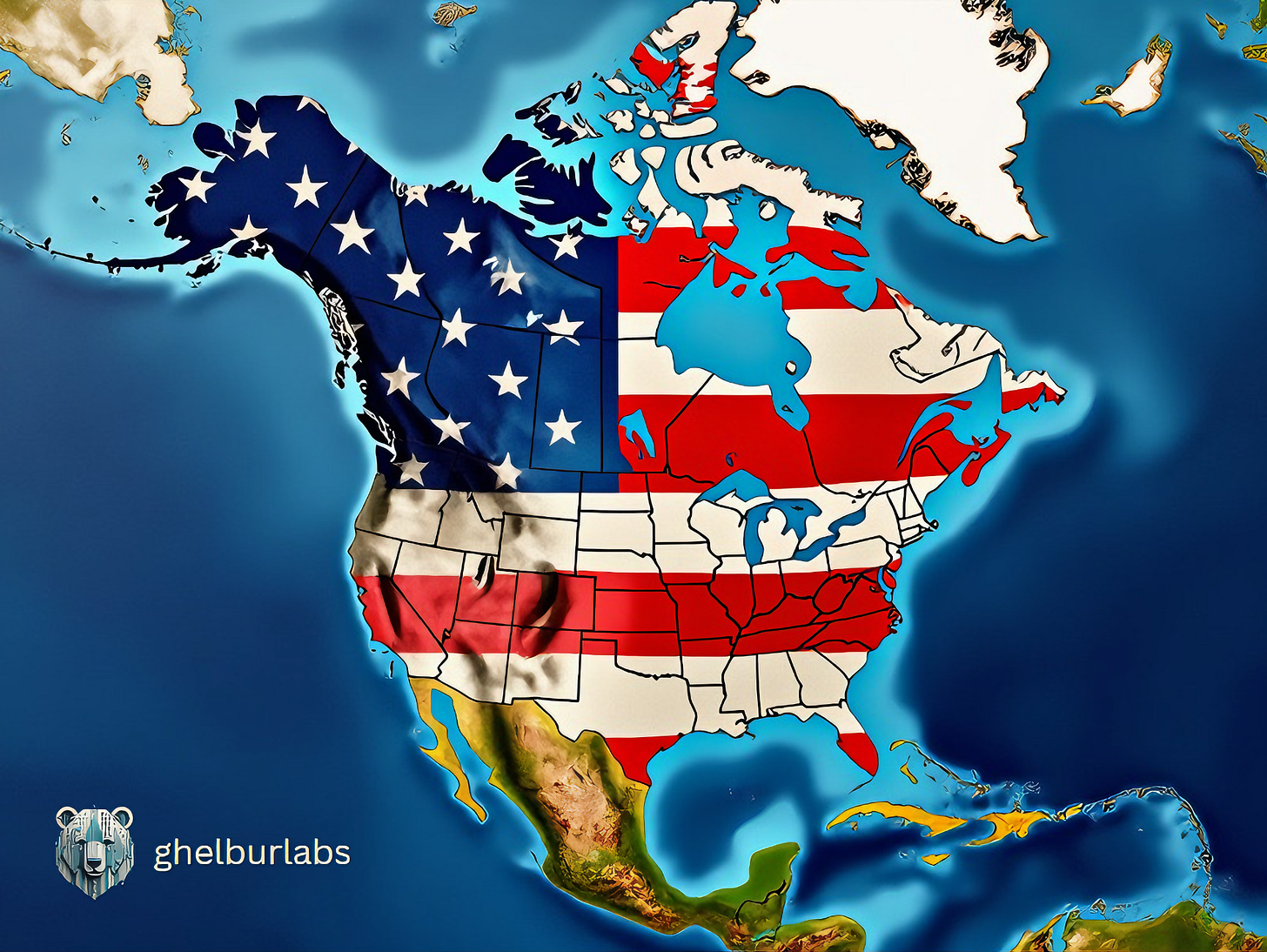




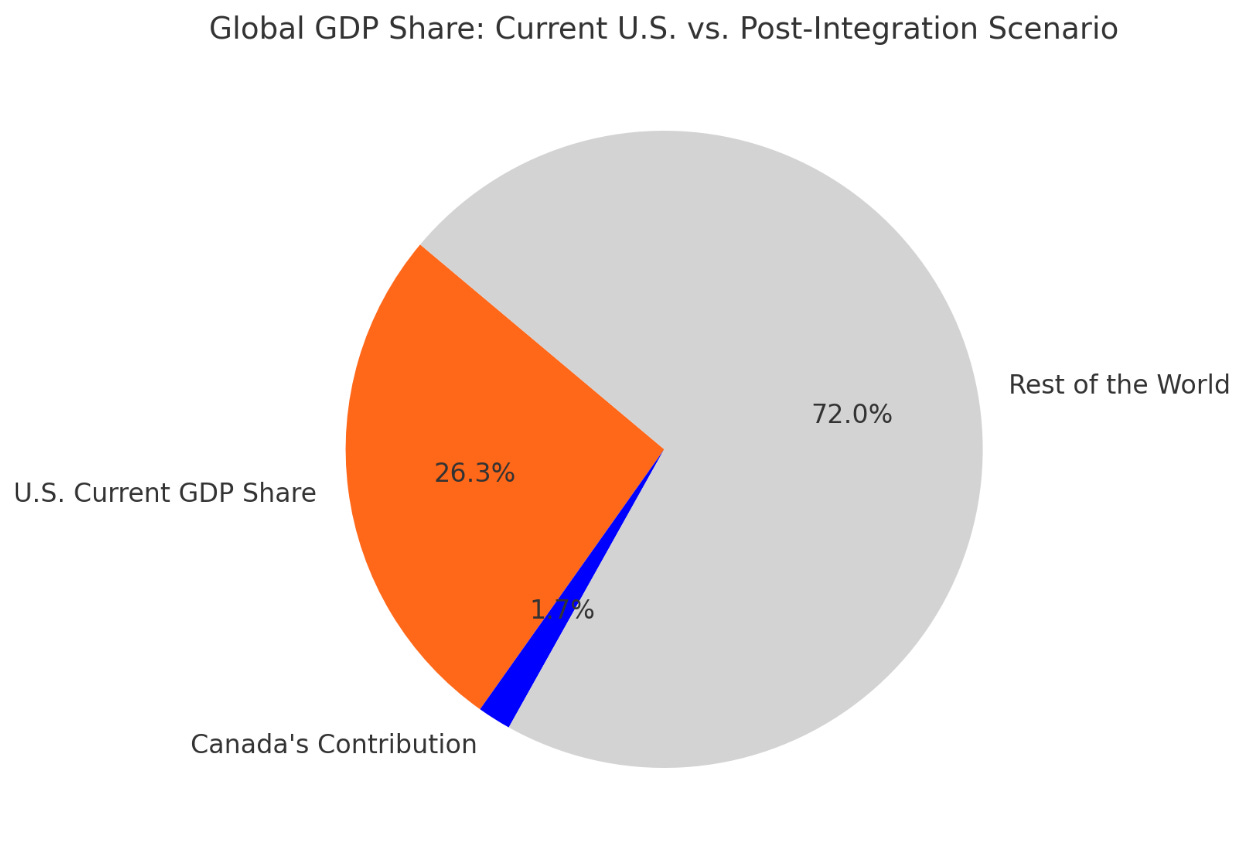
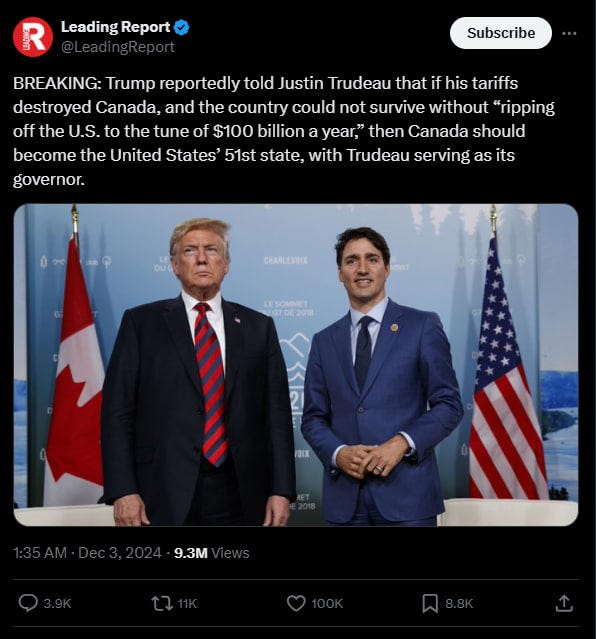

to avoid conflict, the United States would have to make an offer of annexing Canada extremely enticing to Canadians such as dollar parity, lower tax rates, eg income tax, capital gains etc plus zero exit tax if Canadians decide to leave. While I believe it could work, the US government really need to tread carefully in the integration.